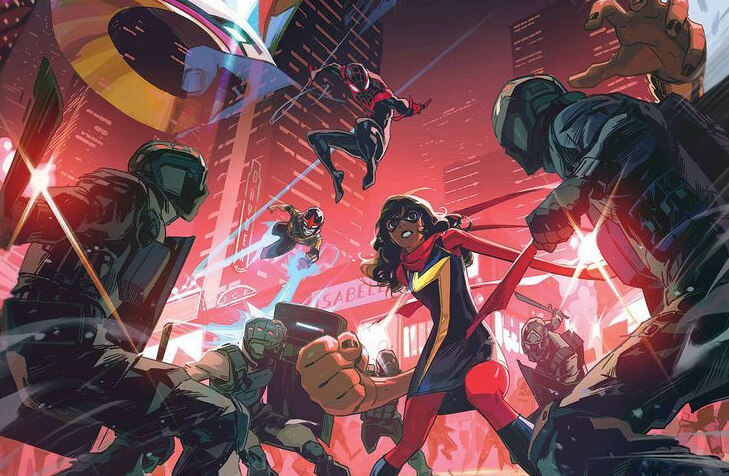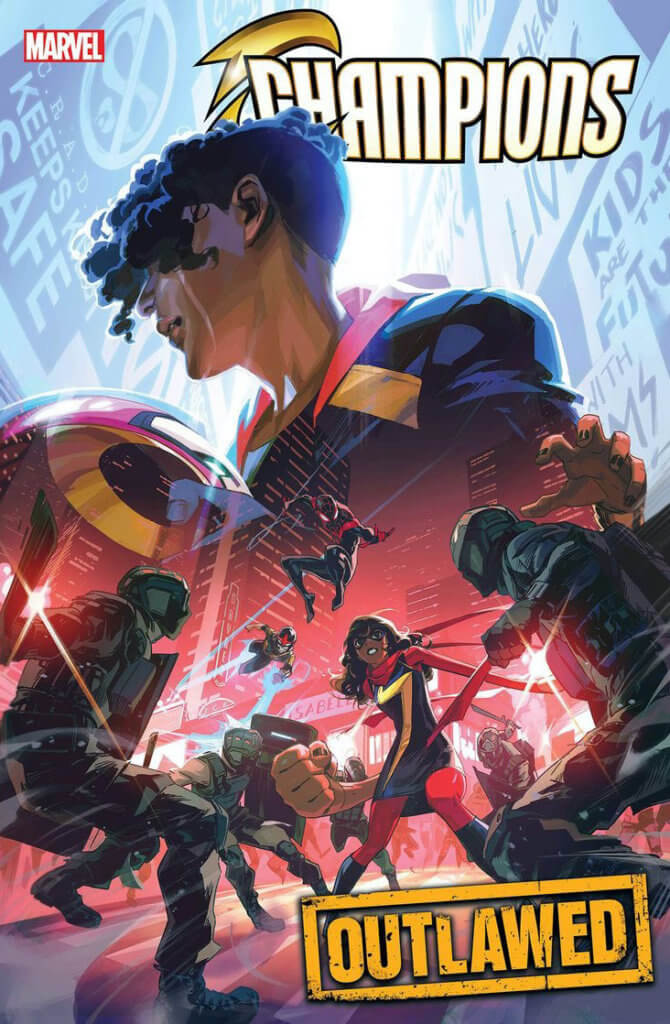Champions #1 was “a lot of talk and not enough action.” Champions #2 isn’t much different, with a lot of dialogue and very few action scenes. Its biggest failure, however, is to not treat its teenage superheroes as superheroes, even as they fight to be recognized as such.
Champions #2
Federico Blee (colorist), VC’s Clayton Cowles (letterer), Simone Di Meo and Bob Quinn (artists), Eve L. Ewing (writer), and Toni Infante (cover)
Marvel Comics
November 11, 2020
Champions #2 opens in a C.R.A.D.L.E. reeducation center, where Champions Locust (Fernanda Rodriguez), Snowguard (Amka Aliyak), Bombshell (Lana Baumgartner), and Starling (Tiana Toomes) are detained. In what is maybe the most cogent political metaphor made over the 20 pages of the comic, the Indigenous Aliyak and Jewish Baumgartner compare the center to residential schools and concentration camps. They’re metaphors that would work even if they weren’t made explicit. The subsequent metaphor, like Simone Di Meo, Bob Quinn, and Federico Blee’s artwork, is muddled.
Di Meo’s artwork, as in the first issue, is all extremes: panels are rarely at 90-degree angles, and when they are, the artwork is not. The level of detail in both Di Meo and Quinn’s work ranges from too much to too little with nothing in between. Although the credits of the issue do not differentiate Di Meo’s pages from Quinn’s, the black, irregular gutters of some pages stand in stark contrast to the white, even gutters of a handful of pages in the second half of the issue. While Blee’s colors blend the two line artists’ work well, they also function in extremes: either too close to life (the superheroes don’t look super) or too far away from it (the backgrounds and effects don’t look as real as the characters). Altogether, it looks like a Phase One MCU film (see: Thor’s Dutch angles), which is not a compliment.
Aliyak and Baumgartner are disappeared from the reeducation center by Rina Patel (Timeslip), another former member of the New Warriors, further closing the distance between the Outlawed event and Civil War (and complicating the racial politics). The comic then cuts away from them entirely by shifting to Chicago, the hometown of Riri Williams (Ironheart) and site of protests against and for Kamala’s Law. The protests are less evocative of those that have been happening since George Floyd was killed by a police officer in Minnesota (which would have happened after writer Eve L. Ewing scripted the comic) and more evocative of those led by teenagers and young adults under the banner of March For Our Lives.
The mission of March For Our Lives is clear-cut: “To harness the power of young people across the country to fight for sensible gun violence prevention policies that save lives.” The protests around Kamala’s Law are, likewise, led by teenagers, although they effect a “both sides” narrative: those against the law are against it because it makes marginalized people more vulnerable, and those for the law are for it because it makes them feel safe. Champions makes it obvious that C.R.A.D.L.E. agents are wrong in their enforcement of Kamala’s Law, affirming the anti-Kamala’s Law protesters, but it does not fully condemn the law or those in favor of it. Further, because the metaphor does not plainly map to any real-world issues, it is unclear if the teenage protesters are meant to align with those who lead March For Our Lives or those protesting police brutality, or those fighting against climate change. These movements intersect but do not wholly overlap, which makes it difficult to represent them in a single metaphor, even one meant to celebrate the agency and actions of teenagers.
As tensions escalate at the protests, Kamala Khan (Ms. Marvel), Miles Morales (Spider-Man), and Sam Alexander (Nova) watch from afar before deciding to take action. That they don’t immediately leap in may be meant to signal maturity; however, it reads more like indecisiveness and ineptitude. They spend twice as much time talking about what’s happening as they do physically engaging. Later, they retreat to Riri’s house, where Kamala accuses Riri of being responsible for the detainment of their teammates before the real traitor is revealed. Both the accusation and the reveal beg the question: maybe the real villains were the friends we made along the way?



